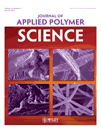Engineering properties of compatibilized polypropylene/liquid crystalline polymer blends
Abstract
Polypropylene (PP) and Vectra A950, a thermotropic liquid crystalline polymer (LCP), blends were prepared in a single-screw extruder with the variation in Vectra A950 content in presence of fixed amount (2%, with respect to PP and LCP mixture as a whole) of ethylene-acrylic acid (EAA) copolymer as a compatibilizer. Mechanical analysis of the compatibilized blends within the range of LCP incorporations under study (2–10%) indicated pronounced improvement in the moduli, ultimate tensile strength (UTS), and hardness. Fourier transform infrared (FTIR) spectroscopy studies revealed the presence of strong interaction through H-bonding between the segments of Vectra A950 and the compatibilizer EAA. Morphological studies performed by scanning electron microscopy (SEM) manifested the development of fine fibrillar morphology in the compatibilized PP/Vectra A950 blends, which had large influence on the mechanical properties. Differential scanning calorimetry studies showed an initial drop of the melting point of PP in the presence of EAA followed by enhancement of the same in presence of Vectra A950. TGA showed an increase in the thermal stability for all blends with respect to matrix polymer PP. Rheological studies showed that a very small quantity of Vectra A 950 was capable of reducing the melt viscosity of PP particularly in the lower shear rate region and hence facilitated processibility of the blends. © 2011 Wiley Periodicals, Inc. J Appl Polym Sci, 2011




